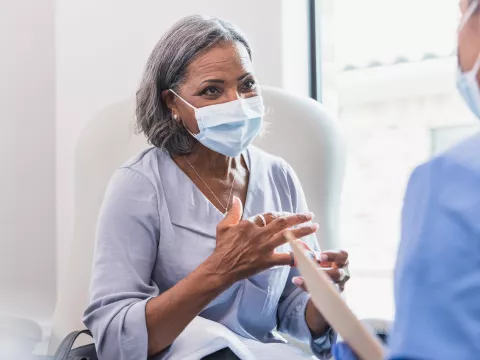- AdventHealth

There are a lot of important things to know about lung cancer, but one of the most important may be what you’ll read right here about lung cancer screenings.
Lung cancer screenings are important to know about because the key to positive outcomes in treating lung cancer is early detection and diagnosis.
One of the reasons that lung cancer is the number one cause of cancer-related deaths in the U.S. for both men and women is because it often has no symptoms until it’s already advanced in stage. Lung cancer screening aims to change this, finding the disease at an earlier stage when treatment is more effective.
What Is a Lung Cancer Screening?
The only proven test for lung cancer screenings is low-dose computed tomography (LDCT). In LDCT, a specific type of X-ray machine scans your body and uses a low dose of radiation to create high-quality images of your lungs. Research has shown that among heavy smokers, LDCT can reduce the risk of losing their lives to lung cancer.
But because this type of screening can detect lung abnormalities that are not cancer and may prompt additional testing or procedures, yearly lung cancer screening is typically only recommended for those at a high risk of lung cancer, which is people ages 55 to 80 with a history of heavy smoking.
If your doctor recommends lung cancer screening, discuss the pros and cons for you, and understand what to expect before, during and after the screening.
To help you feel prepared and empowered, here’s a quick look at what the test entails.
Safety Measures to Expect
If you’re concerned about seeking out a diagnosis or treatment today, please know that taking precautionary measures to protect your health and safety. These include:
-
Enforcing a strict visitor’s policy
-
Practicing social distancing by keeping patients at least six feet apart
-
Taking temperatures of everyone who enters our facilities
-
Treating patients with COVID-19 symptoms in separate areas
-
Wearing protective masks
What to Expect Before the Screening
Metal can affect the quality of an image on LDCT scans. Before your scan, you’ll be asked to remove metal objects, such as jewelry, hairpins, eyeglasses and removable dental work.
What to Expect During the Screening
LDCT is a painless, noninvasive imaging test. In the test, an X-ray machine scans your body in a spiral path. This machine is linked to a computer, which processes the scanned information and creates a series of detailed images. The amount of radiation to which you’re exposed is up to 90 percent less than with a conventional CT scan of the chest.
The machine used for LDCT typically looks like a large box with a short tunnel in the middle. You’ll lie on a table that slides in and out of this tunnel. A technologist will help you get into the right position on the table — usually lying flat on your back.
Once you’re in position, the table slides through the tunnel quickly to find a starting point for the scan. Then the table slides through a second time as the scan is performed. During this scanning process, any motion— even breathing —could blur the image. You’ll need to hold your breath for five to 10 seconds.
What to Expect After the Test
About one in four LDCT screenings find abnormal areas in or near the lungs. Most turn out to be something other than cancer, such as scarring from a past infection. To know for sure and bring you peace of mind, however, you may need follow-up testing.
If this happens, you’ll be asked to come back for another LDCT scan in several months. By comparing the two scans, your doctor can see whether the abnormal area is growing. If it is, your doctor may recommend further evaluation. You might need to get another type of imaging study or a biopsy (removal of tissue for analysis in the lab).
Whatever your health journey brings, it’s important to find a care partner on your path to whole health. With a focus on prevention, our experts can guide you with recommendations on keeping your lungs healthy or determine if a lung cancer screening is right for you.
If you think you might be at risk for lung cancer, talk to your primary care provider about scheduling a screening.
